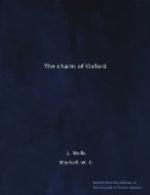A man must, indeed, be a Gothic purist who would wish away the stately front quadrangle of Queen’s, designed by Wren’s favourite pupil, Hawkmoor, while the master himself is said to be responsible for the chapel of the College, the most perfect basilican church in Oxford.
If Queen’s has been revolutionary in its buildings, it has been singularly tenacious of old customs. Its members still assemble at dinner to the sound of the trumpet (blown by a curious arrangement after grace has been said); it still keeps up the ancient and honoured custom of bringing in the boar’s head—“the chief service of this land”—for dinner on Christmas Day; while on New Year’s Day, the Bursar still, as has been done for nearly 600 years, bids his guests “take this and be thrifty,” as he hands each a “needle and thread,” wherewith to mend their academic hoods; the aiguille et fil is probably a pun on the name of the founder, Robert Eglesfield. The College at these festivities uses the loving, cup, given it by its founder, perhaps the oldest piece of plate in constant use anywhere in Great Britain; five and a half centuries of good liquor have stained the gold-mounted aurochs’ horn to a colour of unrivalled softness and beauty.
Robert Eglesfield was almoner of the good Queen Philippa, wife of Edward III, and, like Adam de Brome, the founder of Oriel, he, too, commended his college to a royal patron. Ever since his time, the “Queen’s College” has been under the patronage of the Queen’s consort of England, and the connection has been duly acknowledged by many of them, especially by Henrietta Maria, the evil genius of Charles I, and by Queen Caroline, the good genius of George II. Her present Gracious Majesty, too, has recognized the college claim. The Queens Regnant have no obligations to the college, but Queen Elizabeth gave it the seal it still uses, and good Queen Anne was a liberal contributor to the rebuilding of the college in her day; her statue still adorns the cupola on the front to the High.
[Plate IX. High Street]
No doubt it was the royal connection which brought to Queen’s, if tradition may be trusted, two famous warrior princes, the Black Prince and Henry V; though it is at least doubtful whether the Queen’s poet, Thomas Tickell, Addison’s flattering friend, had any authority for the picture he gives of their college life. He describes them as:
“Sent from the Monarch’s
to the Muses’ Court,
Their meals were frugal
and their sleeps were short;
To couch at curfew time
they thought no scorn,
And froze at matins
every winters morn.”




